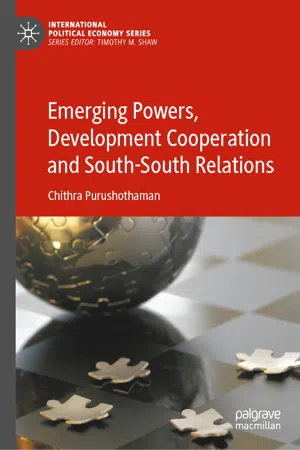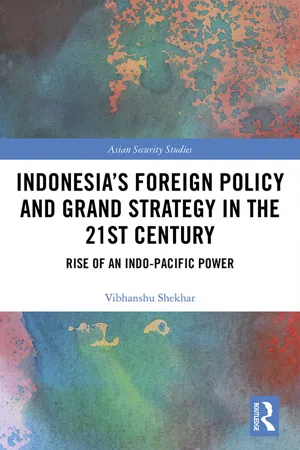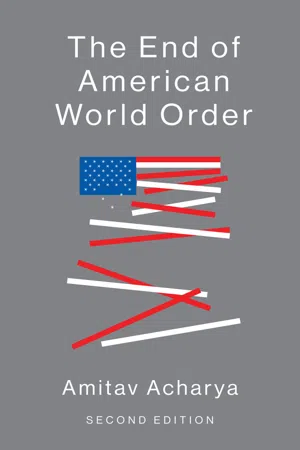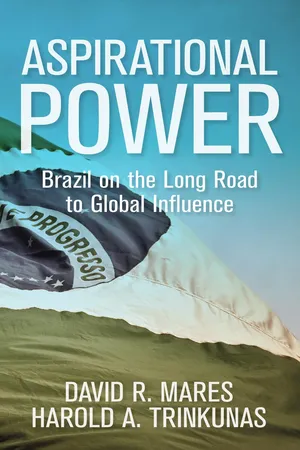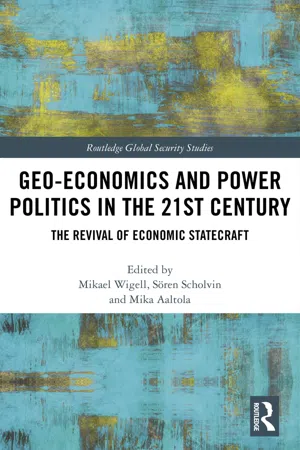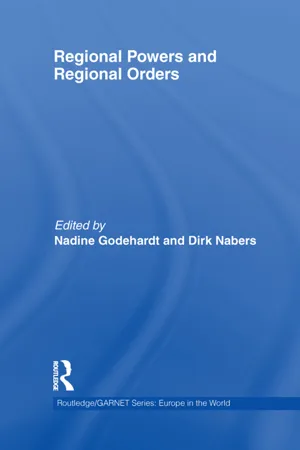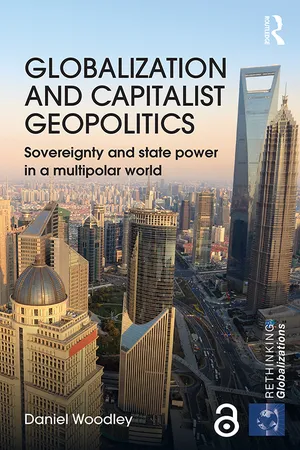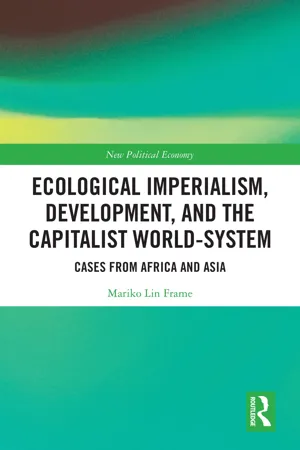Geography
Emerging Powers
Emerging powers refer to countries that are rapidly increasing their economic, political, and military influence on the global stage. These nations are often characterized by their growing industrialization, urbanization, and technological advancements. Examples of emerging powers include Brazil, Russia, India, China (BRIC), and other countries with similar trajectories of development and influence.
Written by Perlego with AI-assistance
Related key terms
Related key terms
1 of 4
Related key terms
1 of 3
9 Key excerpts on "Emerging Powers"
- eBook - ePub
Turkey in the Global Economy
Neoliberalism, Global Shift and the Making of a Rising Power
- Bülent Gökay(Author)
- 2020(Publication Date)
- Agenda Publishing(Publisher)
The rise of the new Emerging Powers was not, and certainly will not be linear, mainly because of the major differences between countries and because of the exceedingly inconsistent internal situation in many of them. Not all emerging economies become Emerging Powers. Economic growth, the size of the population and the size of the country do not automatically necessitate regional, let alone global, leadership. The demands of the criteria are far higher: reliability, having the trust of neighbouring countries, having soft power capability and being able to provide public goods for the region and worldwide. The term “emerging power” is a rather multidimensional concept. Inevitably, some emerging countries will “score highly”, as it were, on some aspects and not others. The precise boundaries of the emerging power are therefore left intentionally fuzzy. Additionally, power is relational, which means that there are not just two but several actors, all aspiring to hegemony and competing with each other for it, and some do not always comply.The current hegemon, the US and its close allies, faced with economic decline and political passivity, are retreating from their global economic and political commitments. After decades of protracted decline, US hegemony, the US-centred hub-and-spokes arrangement, is becoming a thing of the past in the face of the growth of emerging economies, above all that of China (Gowan 2001). The future of the world and its integrating global economy, it seems, will not be determined by the Euro-American powers. The Western world we have known is fast losing its superiority and is being substituted by a new international system that is partly shaped by the arrival of new actors, the Emerging Powers. This is underpinning the breakdown of the global economic order and the turn of the ruling elite in many countries to unconstrained economic and political nationalism. The West, collectively, noticeably does not have the means to back up its policies in the Middle East, in Africa, in Ukraine or in Southeast Asia. The new Emerging Powers, on the other hand, are aspiring to a new order of global politics, but they are not yet in a position to impose their will upon various regional and global conflicts in the world. Potentially, China, India, Brazil and perhaps Russia as a group could guarantee global security, energy supplies, etc. But it will be decades before they are anywhere near reaching great-power capabilities and have enough influence to play such a role. So far, the Emerging Powers have arisen as the new poles in an increasingly multipolar global system; in various regions they are hubs, but for the most part they lack real hegemonic power and the capacity for leadership. - Chithra Purushothaman(Author)
- 2020(Publication Date)
- Palgrave Macmillan(Publisher)
2008 , 1, 2).Gabas and Losch (2008 ) observe that these developing countries were those “underdeveloped category” of countries, which emerged after the Second World War that was later renamed as Third World countries and then rechristened as the Global South (Gabas and Losch 2008 , 15).Andrew Hurrell (2006 ) argues that the Emerging Powers are countries that could be considered as “pivotal states in international relations” (Hurrell 2006 , 9). These countries aim to manoeuvre a greater role and influence, in both their own region and the outside world (Hurrell 2006 , 9; 2008 , 4). It is through their increasing economic capabilities that they hope to change the economic and political setting of the twenty-first century (Hart and Jones 2010 , 65). However, the concept of Emerging Powers presupposes common traits.Chenoy (2010 ) lays out the characteristics of an emerging power , includinghigh growth rates; influence on international economics through purchase of bonds, impact on trade , foreign exchange and competitiveness; stable political systems and demographic depth. They are also found to be high military spenders with huge standing armies. (Chenoy 2010 , 2)These countries, through their increasing military spending and nuclear capabilities, aim to enhance their regional and international influence (Chenoy 2010 ). They are also increasingly found to have strategic partnerships with other developing countries. The group of Brazil, Russia, India, China and South Africa (BRICS) and the group of India, Brazil and South Africa (IBSA) are examples of the Emerging Powers’ groupings that these countries think would enhance their status internationally. Furthermore, these Emerging Powers are also an inevitable part of global governance institutions. The expansion of G-8 into G-20 is a significant reminder of the West’s acceptance of the Emerging Powers as important actors in international politics- eBook - ePub
Indonesia's Foreign Policy and Grand Strategy in the 21st Century
Rise of an Indo-Pacific Power
- Vibhanshu Shekhar(Author)
- 2018(Publication Date)
- Routledge(Publisher)
They are marked by substantial differences ‘in terms of their power and geopolitical importance; economic weight and degree of integration into the global economy; distinctive cultural and historical trajectories; and their domestic political systems’. 11 They are variously labelled as ‘rising powers’, ‘aspiring powers’, ‘leading powers’, ‘major powers’, ‘new-Emerging Powers’, ‘global swing states’, regional powers, ‘emerging markets’, ‘pivotal states’ and ‘middle Emerging Powers’. 12 They are also characterized as would-be great powers and today’s Emerging Powers are on the way to become great powers. 13 These Emerging Powers are also termed as ‘Quasi world powers’, ‘capable of competing for the position of a world power and on the threshold of becoming one in the near future’. 14 Alastair Iain Johnston posits five different approaches to identify a rising power – a historical view (i.e. a state is rising if it is more powerful than the past); a visibility view (a state is more engaged in the world than previously); an influence view (a state increasingly affects the lives of ordinary people); a ‘threat to the hegemon’ view; and an ‘inter-subjective expectations’ view (i.e. a state is rising if other states view it as having a larger role in the world than in the past). 15 While the first and third approaches relate to an increase in the states’ capabilities as a defining element of the Emerging Powers, the second and fifth approaches relate to international recognition of emerging power status. The fourth view of Emerging Powers as a threat to the hegemon allude to the ways in which Emerging Powers express their international ambition - eBook - ePub
- Amitav Acharya(Author)
- 2018(Publication Date)
- Polity(Publisher)
4 Emerging Powers The Hype of the Rest? The terms “Emerging Powers” and “rising powers” recognize the growing economic as well as political and strategic status of a group of nations, most if not all of which were once categorized (and in some accounts still are) as part of the “third world” or “global South.” The definition of who belongs in these categories is neither fixed nor uncontroversial. These terms are often used to include countries such as the BRICS as well as Indonesia, Mexico, Argentina, Australia, Saudi Arabia, South Korea, and Turkey. Andrew Cooper has observed that “the depiction of rising powers” has been “expansive, fluid, and contested … No one acronym has the field to itself.” 1 The same can be said of the term “Emerging Powers.” For example, despite its seeming conflation with “Emerging Powers,” the term “rising powers” is normally associated with countries that have a clear potential to become great powers, such as China, India, and Brazil. The term “Emerging Powers” indicates countries such as Indonesia, South Korea, Mexico, Nigeria, and South Africa, which are not perceived to be headed for international great-power status. (For convenience, I will use the term “Emerging Powers,” a broader category which subsumes “rising powers.”) Russia is an odd presence in the ranks of the rising/Emerging Powers category, since it is really a traditional European great power, which was also a military superpower during the Cold War. (In the post-Cold War era, some saw it prematurely, as an “outdated great power.” 2) Another term that complicates the picture is that of “regional powers,” a category that relies more on physical and material attributes of a country relative to its immediate neighbors. Not all Emerging Powers are counted as regional powers, though - eBook - ePub
Aspirational Power
Brazil on the Long Road to Global Influence
- David R. Mares, Harold A. Trinkunas(Authors)
- 2016(Publication Date)
- Brookings Institution Press(Publisher)
Brazil’s efforts to emerge as a global power are particularly important now that international politics are in flux. The unipolar moment that followed the end of the Cold War seems to be slipping away in the face of the Chinese economic and military surge of the past decade and Russia’s desire to contest U.S. leadership along its periphery. In this context, some developing nations such as Brazil and India have increased their military, economic, and political capacities to the point that they appear to be on the brink of emerging out of the classification of a middle power and into a second tier of major power rankings.Although it is common to speak of “rising” countries, the Emerging Powers are important not just because they have accumulated more material resources or military might but also because of their aspirations to influence the way global governance works. Emerging Powers such as India and Brazil are more capable than middle or regional powers such as South Korea, Indonesia, or Mexico—but they are not (yet) great powers.These emerging states are increasingly clamoring for a larger role in global politics and demanding that the governance structures of the international system take greater account of their interests. They are seeking recognition of both their economic importance and their political influence in the international organizations that structure economic, political, and security global governance. It is important to note that although they seek a greater say, states such as Brazil and India do not seek to overthrow the present order.5 In particular, Brazil sees both reform and revision as attainable and beneficial, both for its growth as a major power and for the stability of the international order.From the perspective of U.S. leaders, these questions are primary: What do Emerging Powers want, and are their intentions generally benign or potentially harmful to global order? The United States has to consider whether the interests of Emerging Powers can be incorporated into present international governance structures without long-term damage to the global order it put in place after World War II. The growing power of new actors such as India and Brazil has objective ramifications for the functioning of the international order. But their growing economic, military, and diplomatic power implies little about what these states might do with their expanded capabilities. - eBook - ePub
Geo-economics and Power Politics in the 21st Century
The Revival of Economic Statecraft
- Mikael Wigell, Sören Scholvin, Mika Aaltola, Mikael Wigell, Sören Scholvin, Mika Aaltola(Authors)
- 2018(Publication Date)
- Routledge(Publisher)
15 Geo-economics and geopolitics in sub-Saharan African power politics1Sören ScholvinIntroduction
Over the last two decades, economists, geographers and political scientists have engaged in intense debate about Emerging Powers. In addition to being featured in numerous publications that deal with global issues, Emerging Powers, including South Africa, have often been conceptualised as regional hegemons that advance projects of regional leadership (e.g. Adekeye, Adebayo and Landsberg 2007; Flemes 2009; Schoeman 2003; Schoeman and Alden 2003; Scholvin 2013; Simon 1998). In spite of frequent claims that not only leaders but also potential followers are the subject of scrutiny (e.g. Cooper, Higgott and Nossal 1991), research on how other states react to the leadership projects of Emerging Powers remains thin. For sub-Saharan Africa, even general studies of the foreign policies of what Ebert, Flemes and Strüver (2014) call ‘secondary powers’ – that is, the second-most powerful states in regional hierarchies – are scarce.2In this chapter, I bring the empirical gap of research on secondary powers together with a key question regarding the concept of geo-economics. Scholars who coined the term in the early 1990s, in particular Huntington (1993) and Luttwak (1990), were convinced that military means of power had become redundant and were being replaced by economic means that states now apply in pursuit of their foreign policy objectives. However an increasing number of researchers to whom I refer below argue that geo-economics and geopolitics co-occur. The two types of geostrategy hardly ever stand on their own. It appears that whilst some states put more emphasis on military might and occasionally refer to economic power (e.g. Wigell and Vihma 2016), others simply back-up their geo-economic practices with brute force as an ultima ratio (e.g. Chapter 8 - eBook - ePub
- Nadine Godehardt, Dirk Nabers(Authors)
- 2011(Publication Date)
- Routledge(Publisher)
- Buyers and sellers, creditors, and debtors affect economic transactions at the operational level. Economic power is thus always the result of a bargaining process; that is, it is relational.
Technology and hegemony
According to Richard R. Nelson and Gavin Wright, emerging nations can initiate a catching-up process and thereby ascend to the position of technologically leading nations. This depends above all on them: (1) raising the total factor productivities,4 (2) increasing the investment and savings rates and (3) identifying new organizational forms in industry and the ‘political economies’. What is meant by this is that today’s global society is a network society and that research can be imitated anywhere, which means that technology can become a ‘public good’. Rising nations, such as regional powers, can use investments in education and in research and development (R&D) to more easily adapt developed countries’ technology, and thereby advance (Fan 2008 ;Altenburg et al. 2008; Nayyar 2008 ; Frietsch and Schüller 2010 ). Thus, according to Nelson, what regional powers need to develop their power status, aside from a mass-production market, is first and foremost technological leadership.Newer studies fromRicardo Hausmann and Dani Rodrik (2003)support this view. The authors compare the technology-adaptation process of companies in developing countries directly with the innovation process in industrialized countries. They model technological adaptation as a business process that involves similar risks and costs to the innovation process. Accordingly, regional powers do not simply dominate their neighbour countries: through local technological efforts the neighbouring countries in the region can increase their own productivity and develop technologically, meaning that they have something to use as leverage against the regional powers (Keller 2004 ).Power imbalances and asymmetries
Regional powers influence neighbouring states in various ways. They can make their influence felt through: (1) the granting of development aid to alter the political balance in other countries, (2) the strategic granting of contracts to foreign companies or (3) the exercise of pressure on international organizations so that ‘friendly governments’ can receive ‘good deals’. - eBook - ePub
- Daniel Woodley(Author)
- 2017(Publication Date)
- Routledge(Publisher)
A number of innovative and dynamic emerging-market firms are on a path toward dominating their industrial sectors globally – much in the same way that companies based in advanced economies have done over the past half century. Many emergingmarket firms have already begun overtaking their advanced-country competitors in terms of the priority accorded to developing innovative technologies and industrial processes, with 114 firms from emerging economies ranking among the top 1000 firms worldwide by R&D spending as of 2009, twice as many as five years earlier. (World Bank 2011: 5) This is in large part due to the determination of developing economies in Asia to catch up with Japan and the West, but it is also due to the expansion and intensification of economic transmission channels between developed and emerging market economies, both of which now constitute ‘growth poles’ in the global economy supported by new concentrations of financial capital. In a World Bank study of the multipolar economy, a ‘growth pole’ is defined as any ‘economy whose domestic growth helps drive the growth process in other economies’ (World Bank 2011: 16), in other words, an engine of capital accumulation. The term ‘growth pole’ was initially used to refer to ‘agglomerations of firms or industries in which growth is concentrated and that had linkages to each other and to peripheral firms. Since then, the term has been applied to an increasingly varied set of related concepts, with “growth pole” quickly taking on a spatial or geographic dimension’ (ibid.). The idea of growth polarity has since been ‘extended to the global scale while simultaneously becoming somewhat enmeshed with the concept of polarity (sites of geopolitical/geoeconomic power) being developed in the international relations literature’ - eBook - ePub
Ecological Imperialism, Development, and the Capitalist World-System
Cases from Africa and Asia
- Mariko Lin Frame(Author)
- 2022(Publication Date)
- Routledge(Publisher)
Semi-Peripheral and Regional Sub-ImperialismDOI: 10.4324/9780429261305-5In the past several decades, the capitalist global economy has witnessed a world-systemic shift as global capital and productive activities have relocated from core economies to formerly peripheral economies through the activities of transnational corporations shifting their manufacturing processes overseas in search of cheaper sources of labor. The industrialization of semi-peripheral “emerging economies” constitutes a central feature of neoliberal globalization and current-day imperialism with profound planetary ecological consequences. Despite this world-systemic change, the industrializing semi-periphery remains undertheorized in terms of both imperialism (Bond, 2018 ) and ecologically unequal exchange (Frame, 2018 ). By overviewing recent world-systems literature on the growth of the industrializing semi-periphery, extant empirical literature from the sustainability sciences, and a short case study of China’s growing influence in Southeast Asia, this chapter seeks to lay preliminary theoretical foundations for semi-peripheral ecological imperialism and ecologically unequal exchange.In the US media, the growing presence of emerging economies such as China in overseas investments is an increasing competitive concern, and the spate of anti-Chinese media articles whips up one-dimensional portraits of Chinese imperialism overseas. However, the reality of the situation is more complex. Ecological sub-imperialism emanating from emerging economies is qualitatively different from core imperialism. For one, emerging economies are competing in a capitalist world-system still dominated by core economies. They also serve as manufacturing platforms to transnational corporations largely headquartered in the Global North. While semi-peripheral states may be industrializing, major profit-oriented activities still congregate in core economies. Empirical studies have shown that while such countries have emerged as economic powers, they have not gained core status in terms of wealth. Importantly, from the perspective of ecological imperialism, the industrialization of the semi-periphery has resulted in some of the most egregious forms of environmental destruction as TNCs from the developed countries have outsourced materially and energy-intensive production processes through global production chains. In the industrializing semi-periphery, the exploitation of cheap labor and the degradation of Nature are intimately interlinked in one process—the production of global consumer goods, many of which are exported to the Global North. This dual exploitation of labor and Nature in the semi-periphery has bolstered the unsustainable consumption patterns of consumers in the developed countries and the profits of Northern TNCs and is a defining feature of contemporary ecological imperialism.
Index pages curate the most relevant extracts from our library of academic textbooks. They’ve been created using an in-house natural language model (NLM), each adding context and meaning to key research topics.
Explore more topic indexes
Explore more topic indexes
1 of 6
Explore more topic indexes
1 of 4

